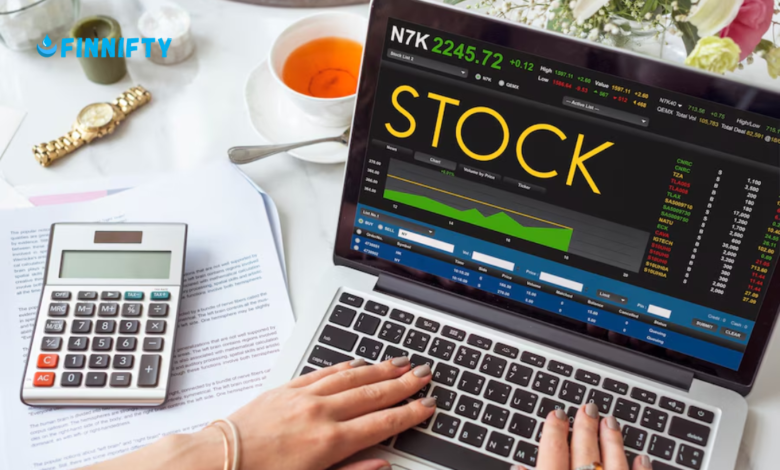LTP in Stock Market: A Comprehensive Guide 2024

In the fast-paced world of LTP in Stock Market trading, one of the most crucial concepts to understand is the Last Traded Price (LTP). At Finnifty, our goal is to make stock trading easy to grasp for everyone, from beginners to seasoned traders. Whether you’re interested in learning about the nuances of stock exchange dynamics or are actively looking for live trading charts, understanding terms like LTP is vital for your success. In this article, we’ll break down what LTP in Stock Market is, why it matters, and how you can use it to make informed trading decisions. And we’ll add a dash of fun to the discussion—after all, learning about the stock market doesn’t have to be boring!
What is LTP (Last Traded Price) LTP in Stock Market?
The Last Traded Price, or LTP in Stock Market, refers to the most recent price at which a stock, commodity, or security was traded. In simple terms, it’s the last price agreed upon by a buyer and seller before the trade occurred.
When you look at live trading charts on Finnifty, the LTP in Stock Marketis one of the key indicators you’ll see. It changes every time there’s a new transaction, making it a dynamic figure that represents the stock’s most recent value in the market.
Why is LTP Important for Traders?
For traders in India’s stock market, knowing the LTP can help make quick decisions, especially in live trading sessions. Unlike the closing price, which only shows the final value at the end of the trading day, the LTP gives a real-time snapshot of market movements. It can help traders gauge momentum and decide whether to buy or sell in the moment.
Imagine watching your favorite cricket match, where the score changes every ball. You wouldn’t want to only know the final score at the end of the game—you want live updates. That’s exactly what LTP does for you in the stock market!
For more in-depth information about stock trading in India, feel free to check out our About Us page on Finnifty, where we dive deeper into trading strategies, tools, and tips.
How LTP in Stock Market Impacts Trading Decisions
LTP is like a live scoreboard for stocks, and it directly impacts your trading decisions. If you’re day trading or engaging in intraday trades, paying attention to LTP is crucial. Traders often use it to:
- Monitor Real-Time Movements: Since LTP changes with every trade, it helps track live market fluctuations.
- Make Quick Decisions: For fast-paced traders, LTP serves as a trigger to make buy or sell decisions.
- Gauge Market Sentiment: If the LTP is trending up or down significantly, it might indicate positive or negative market sentiment.
Let’s say you’ve been keeping an eye on Reliance Industries shares. The LTP at 10:00 AM might be ₹2,400, but by 11:30 AM, it’s shot up to ₹2,450. If you see a continuous upward trend in the LTP, you might decide it’s time to sell for a profit. Conversely, if the LTP is falling, you may decide to hold or buy more if you’re confident the stock will bounce back.
LTP vs. Other Stock Prices: Understanding the Difference
The LTP isn’t the only price you see on a live trading chart. You’ll also encounter terms like:
- Bid Price: The highest price a buyer is willing to pay.
- Ask Price: The lowest price a seller is willing to accept.
- Closing Price: The last price a stock trades at before the market closes for the day.
- Opening Price: The price at which a stock starts trading when the market opens.
Understanding the difference between these prices and LTP is crucial for developing a solid trading strategy. If you’re new to trading, check out our beginner’s guide on Finnifty, where we explain these terms in even more detail.
LTP in India’s Stock Market: A Local Perspective
India’s stock exchanges, like the National Stock Exchange (NSE) and Bombay Stock Exchange (BSE), operate at high speeds, with LTP in Stock Market updates happening in real time. Traders in India need to stay sharp, especially since our markets can be volatile. The LTP of popular stocks, such as Tata Motors or Infosys, can shift dramatically during trading hours, creating opportunities for profit—or loss.
And while you’re navigating these markets, don’t forget that staying updated with live trading charts is crucial. At Finnifty, we provide real-time data to help you stay ahead of the curve. For more detailed inquiries, feel free to Contact Us anytime!
A Fun Perspective: How LTP is Like Watching a Sports Game
Let’s get a little creative! Imagine you’re at a live football match. The score is constantly changing as players move, score, and defend. Just like in football, where every second counts, the LTP in stock trading reflects real-time shifts in a stock’s value. A trader watching LTP is like a fan keeping a close eye on every move in the game, waiting for the perfect moment to celebrate—or make the next big decision.
LTP and Volatility: The Thrill of Live Trading
For thrill-seekers who love the excitement of live trading, LTP can offer an adrenaline rush. Imagine seeing a stock like HDFC Bank or Adani Enterprises shoot up in value within minutes. That spike in the LTP could lead to high profits if you’re quick on your feet. However, the LTP can also drop just as fast, so it’s crucial to act with caution.
In India’s stock market, volatility is a constant companion. Whether you’re a day trader or a long-term investor, understanding LTP can help you navigate these fluctuations with more confidence.
How to Use LTP Data for Trading
Here are some practical ways to use LTP data in your trading strategy:
- Track Price Movements: Use LTP to monitor real-time price movements. It can help you spot trends and momentum shifts in a stock’s value.
- Set Alerts: Most trading platforms, including Finnifty, allow you to set price alerts. When the LTP of a stock hits a certain value, you get notified.
- Check Liquidity: LTP gives you an idea of the stock’s liquidity. If the LTP is fluctuating rapidly, it might indicate high trading volume and liquidity.
- Stop-Loss and Target Orders: Use LTP to set stop-loss and target orders, helping you lock in profits or minimize losses in volatile markets.
The Future of LTP in Stock Market
With technological advancements LTP in Stock Market platforms, the LTP will continue to be a vital indicator for traders. AI-powered trading bots, high-frequency trading systems, and enhanced live trading charts will likely make LTP tracking even more critical.
At Finnifty, we stay updated on the latest developments in the stock exchange and stock trading technology in India. Our mission is to provide you with cutting-edge tools and knowledge, all while keeping things interesting and engaging. We believe that trading should be both informative and entertaining—like a live-action sports game where every moment counts!
Conclusion: LTP—Your Key to Success in Stock Trading
The LTP in Stock Market is a small but mighty concept in the world of stock trading. Whether you’re a day trader, swing trader, or long-term investor, understanding and utilizing LTP can make a significant difference in your success. It provides real-time insight into market movements and offers valuable information that can shape your trading decisions.
So, the next time you check the live trading charts on Finnifty, keep an eye on that LTP—because it just might be the key to unlocking your next big trade!
For more resources, tips, and real-time updates on stock trading in India, explore the other sections of our website, including the informative About Us and Contact Us pages.





